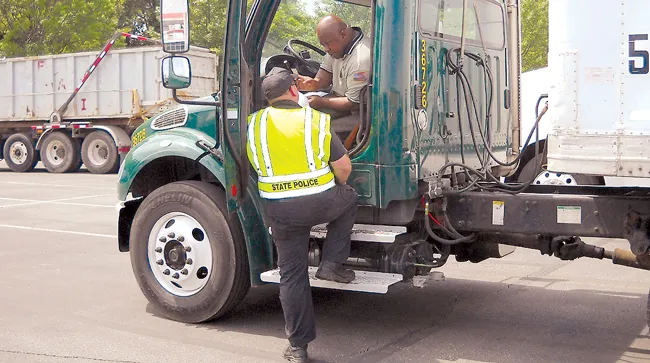Senior Reporter
FMCSA Targets Falsified ELD Records in New Approach

[Stay on top of transportation news: Get TTNews in your inbox.]
Faced with evolving tactics to bypass hours-of-service rules, the Federal Motor Carrier Safety Administration is taking steps to combat electronic logging device fraud. The agency is launching a multipronged approach to address what it describes as a “moving target.”
In particular, the agency cited National Transportation Safety Board concerns with so-called ghost drivers as well as drivers utilizing multiple ELD accounts, and it is exploring various technological requirements to target those specific issues. It also is monitoring ELD performance data, training enforcement personnel to identify and act against fraud, removing noncompliant ELD providers from the market, and updating its ELD rules.
“FMCSA is committed to staying diligent with its fraud prevention efforts,” an agency spokeswoman said in a statement. “FMCSA continues to explore other methods to decrease ELD fraud in both the short and long term.”
A fatal December 2022 crash in Virginia put a spotlight on ELD fraud after a tractor-trailer driver for Illinois-based Triton Logistics was able to — with apparent participation from the carrier — falsify his ELD records to extend his driving time beyond the 11-hour regulatory maximum limit. The truck he was driving during early morning hours along Interstate 64 near Williamsburg, Va., came upon and crashed into a party bus after he failed to take evasive action or brake in time, according to the NTSB investigation. NTSB cited fatigue as a factor in the crash.
“We found that the truck driver’s lack of response to the slow-moving vehicle in his travel lane was due to fatigue from excess driving time and lack of sleep opportunity,” said the NTSB report, recently made public. “The truck’s motor carrier, Triton Logistics, created fictitious driver accounts for some of its vehicles’ electronic logging device systems that enabled drivers to operate beyond federal regulations, creating an opportunity for fatigued driving.”

A state police officer inspects a driver's records during a Roadcheck event. (TT File Photo)
Three occupants in the party bus died, nine sustained serious injuries, and 11 sustained minor injuries. The truck driver also was seriously injured.
Triton did not return a message left by Transport Topics seeking comment. However, NTSB said the company’s CEO denied knowledge of the fictitious logins and said it conducted internal checks to determine how the incident happened.
The driver detailed the scheme for NTSB investigators. He said whenever he reached his 11-hour limit, he could call the carrier’s HOS department — based in Lithuania — and add the name of a fictitious or former co-driver to the ELD, opening up another 11-hour driving window. If asked by a roadside inspector about the double login, the driver would tell the inspector that he dropped off his co-driver at a truck stop for a family emergency. The driver noted that other drivers used the login scheme to extend time behind the wheel.
McLeod Software CEO Tom McLeod explores the potential for artificial intelligence to boost efficiency and build resilience. Tune in above or by going to RoadSigns.ttnews.com.
After the 2022 crash, FMCSA conducted an on-site review of Triton and issued violations related to drivers making false reports regarding duty status as well as requiring or permitting drivers to extend driving time beyond 11 hours. After the review, FMCSA assigned Triton a conditional safety rating.
With an eye toward remedial action, NTSB concluded that a data-entry tracking history in ELD software could increase accountability and transparency, and also deter motor carrier personnel from making false entries aimed at circumventing HOS regulations. Investigators recommended that FMCSA revise its requirements to require ELD providers to create an audit log that includes the date, driver login time and identity of who logged them in, driver’s license numbers, the names of anyone who edits a log, and any changes to active driver lists. NTSB also recommended that the Commercial Vehicle Safety Alliance inform its members about the scheme and circumstances surrounding the Williamsburg crash.

Currie
Senior NTSB investigator Shawn Currie told Transport Topics if the driver’s name was John, he’d be logged in as Frank and then operate with a new 11-hour HOS time limit. “The hours of service, whether you agree with them or not, are there to prevent drivers from driving in excess of the rules, and to ensure they have the appropriate time off,” Currie said. He noted that the circumstance of the Williamsburg case could result in FMCSA fines and possibly criminal penalties if the state elected to bring charges.
Jeremy Disbrow, a Commercial Vehicle Safety Alliance roadside inspection specialist, said inspectors encounter false ELD log entries “all day, every day. Of course, many of the false entries can’t be proven, or they go unnoticed.”
He said the issue is known to CVSA inspectors. “We just discussed all this in a conference after the NTSB report came out,” Disbrow said. “It was pretty clear from the inspectors around the country that this isn’t an isolated incident by any means. The average inspector is seeing this every shift, at least once or twice. There’s a number of ways that they’re falsifying [logs].”
Want more news? Listen to today's daily briefing above or go here for more info
This can include simply using tools available on some devices, he said.
“Drivers can make edits,” Disbrow noted. “If a driver makes an edit on the device himself, it will show up as an edit, and a suspicious inspector can see that. But if a carrier in their back office makes the edit, there are instances where it’s been done but doesn’t show up as an edit.”
Disbrow noted it’s risky to publicly discuss the varying methods. “It’s hard to talk about it because I don’t want to give people ideas,” he said. “I don’t want the industry to say, ‘Hey we can try that.’ As the years are going by, people are finding new workarounds. It’s a cat and mouse game.”
He added, “The hours-of-service rules are there to protect everybody. Thwarting them and running an extra five, six, seven hours without adequate rest is absolutely a recipe for fatigue.”





